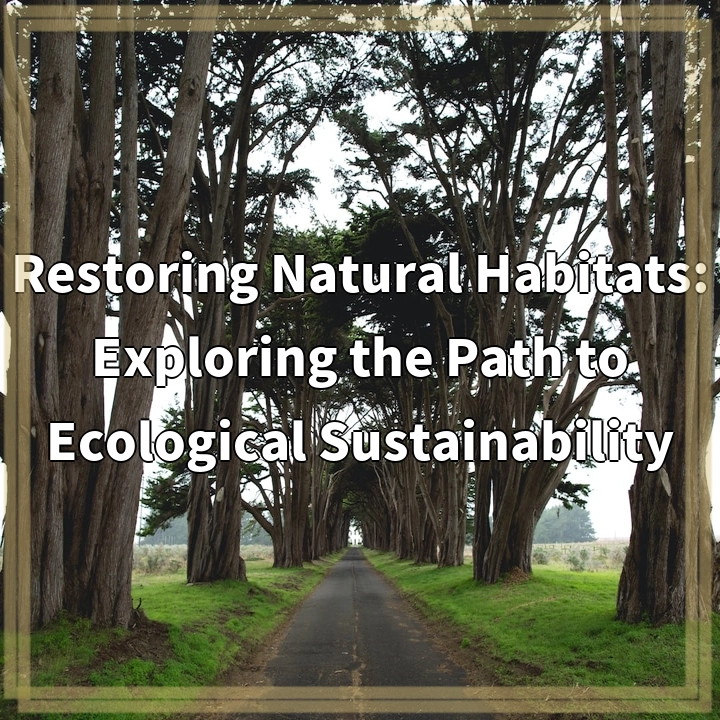
What is Restoring Natural Habitats?
Restoring natural habitats refers to the process of returning degraded or altered ecosystems to their original state, with the aim of promoting ecological sustainability. This involves identifying areas that have been impacted by human activities, such as deforestation, pollution, or urbanization, and implementing measures to rehabilitate these areas. The goal is to enhance biodiversity, improve ecosystem functions and services, and create a more balanced and resilient environment.
Real-World Problems Associated with Restoring Natural Habitats
1. Limited Resources
One of the main challenges in restoring natural habitats is the availability of limited resources. Restoring ecosystems can require significant financial investments, as well as time, skilled labor, and equipment. Lack of adequate funding and resources can hinder restoration efforts and limit the scale and effectiveness of projects.
2. Fragmentation and Loss of Biodiversity
Fragmentation and loss of biodiversity are significant problems related to habitat restoration. Human activities such as urban development and agriculture often result in fragmented habitats, which can negatively impact species’ ability to move, find resources, and reproduce. Restoring habitats alone may not be sufficient to ensure the return of a diverse range of species, as other factors such as connectivity and conservation of nearby habitats also play a crucial role in supporting biodiversity.
3. Invasive Species
Another challenge in habitat restoration is the presence of invasive species. Invasive plants, animals, and pathogens can outcompete native species, disrupt ecosystem interactions, and hinder the recovery of natural habitats. Dealing with invasive species requires careful planning, monitoring, and management strategies to prevent their spread and minimize their impact on restored ecosystems.
4. Climate Change
Climate change poses a significant threat to the success of habitat restoration efforts. Rising temperatures, changing rainfall patterns, and extreme weather events can affect the survival and growth of restored habitats and the species within them. Restoration plans must take into account climate change projections and consider adaptive measures to ensure the long-term resilience and sustainability of restored ecosystems.
5. Stakeholder Engagement and Collaboration
Engaging stakeholders and fostering collaboration is essential for successful habitat restoration. Projects often involve multiple stakeholders, including government agencies, community groups, non-profit organizations, and private landowners. Balancing different interests, addressing conflicting objectives, and ensuring the active participation of local communities are crucial for achieving long-term restoration goals.

Solutions for Restoring Natural Habitats
1. Increased Funding and Resources
Securing adequate funding and resources is crucial for successful habitat restoration. Governments, organizations, and individuals should prioritize investment in restoration projects to ensure their effective implementation and long-term sustainability.
2. Integration of Connectivity and Conservation
Alongside habitat restoration, efforts should also focus on promoting connectivity and conservation of nearby habitats. This approach ensures the establishment of functional ecosystems that can support a diverse range of species and enable their movement and interactions.
3. Effective Invasive Species Management
To address invasive species, comprehensive management strategies are required. These strategies can include early detection and rapid response programs, as well as the implementation of control measures to prevent the spread and minimize the impact of invasive species on restored habitats.
4. Climate-Resilient Restoration Designs
In light of climate change, habitat restoration plans should incorporate climate change projections and integrate adaptive measures. This can involve selecting native species that are resilient to changing climatic conditions and implementing design features that enhance the resilience of restored habitats.
5. Meaningful Stakeholder Engagement
Engaging stakeholders and fostering collaboration is crucial for successful habitat restoration. By involving local communities, government agencies, and other relevant stakeholders, restoration efforts can benefit from local knowledge, ensure community buy-in, and address social and economic needs alongside ecological goals.
By implementing these solutions, restoration efforts can overcome the challenges associated with restoring natural habitats and move closer to achieving ecological sustainability.















